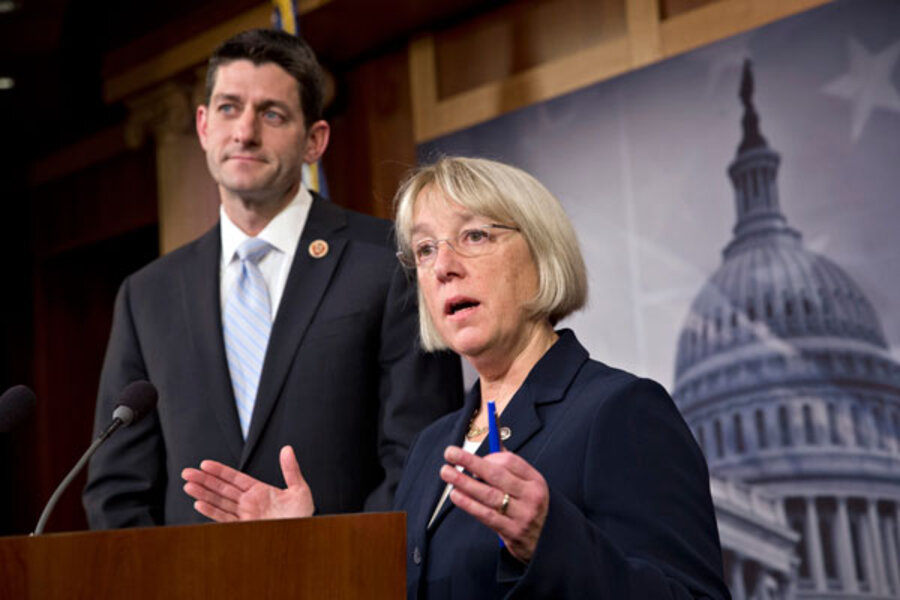Two-year budget deal struck: what you need to know
| Washington
House and Senate budget negotiators in Washington have reached a deal to fund the federal government and avoid a government shutdown on Jan. 15. It comes after much fiscal turbulence, including the first government shutdown in 17 years in October.
Here are the basics:
Q. Does this mean the budget drama is over?
A. If the House and Senate approve of the deal, which was hammered out by budget negotiators Rep. Paul Ryan (R) of Wisconsin and Sen. Patty Murray (D) of Washington, the government will be funded for the next two fiscal years. That means a reprieve from budget brinkmanship – and shutdown. But another fiscal landmine could explode. The United States will hit its debt ceiling in the first half of next year. If lawmakers refuse to raise the ceiling, the US could face the possibility of defaulting on its debt – sending economic shockwaves around the world.
Q. This is a relatively small deal. So why is it important?
A. This agreement is more important for its politics than for its numbers. The compromise is indeed small, funding the government at $1.012 trillion annually – about halfway between the Senate budget of $1.058 trillion and the House budget of $967 billion. It softens the automatic spending cuts, known as the “sequester,” by only $63 billion, but doesn’t get rid of it. It splits the sequester relief evenly between the Pentagon and nondefense programs. [Editor's note: The original version has been changed to give the correct dollar amount for the original House budget.]
Its significance is that there is a deal at all. The House and Senate have not been able to agree on a budget since 2009. The haggling, brinkmanship, and uncertainty, not to mention the October government shutdown, have had a drag effect on the economy, tarnished America’s reputation overseas, and fed the partisanship that has Americans now so disgusted with Congress.
“It’s a good step in the right direction that can hopefully rebuild some trust and serve as a foundation for continued bipartisan work,” said Senate Budget Chairman Murray in a statement.
Q. You said it’s a small deal. What’s missing?
A. This is no “grand bargain.” It does not trade tax increases – as Democrats want – for significant cuts to the expensive programs that drive long-term debt, such as Medicare and Social Security. That’s what Republicans wanted. In fact, it doesn’t really deal with long-term debt at all. What it does do is put a small dent in the deficit, reducing it by between $20 billion and $30 billion.
Q. Given the polarization in Washington, how was it possible to reach this agreement?
A. It’s precisely because its scope is so narrow that Ryan and Murray were able to come to agreement. They knew they would not be able to get their respective caucuses to agree to the big stuff, or even what some consider medium stuff – such as closing corporate tax loopholes or using a less costly method of figuring Social Security checks.
The other reason they could agree is because they were the ones working it out. They may be ideological opposites, but they are both highly pragmatic. And they adhered to that warning about too many cooks in the kitchen spoiling the broth. This was a Ryan-Murray creation, which certainly makes it easier to actually put a deal on the table.
Q. What happens next?
A. The House is expected to take up the agreement, called the Bipartisan Budget Act, before its recesses for the Christmas holiday on Friday. Then it’s the Senate’s turn. But it’s still not certain that the bill will pass both houses. Democrats will be upset that the deal does not include an extension of jobless benefits, set to expire later this month. Conservatives will be upset that the full sequester is not in force, and that a more serious attempt at debt reduction was not made.
Some conservatives have already begun lining up against the deal. Influential tea party leader Rep. Tim Huelskamp (R) of Kansas said on CNN's "Crossfire" Tuesday that he will not vote for it. That means House Speaker John Boehner (R) of Ohio might need to rely on Democratic votes to get the deal through the House – something he has been reluctant to do in the past.
But Ryan said the deal “reduces the deficit – without raising taxes.” It is a “firm step in the right direction.”
In Washington, where it is so difficult to put a foot forward, one step can seem like a giant leap.









